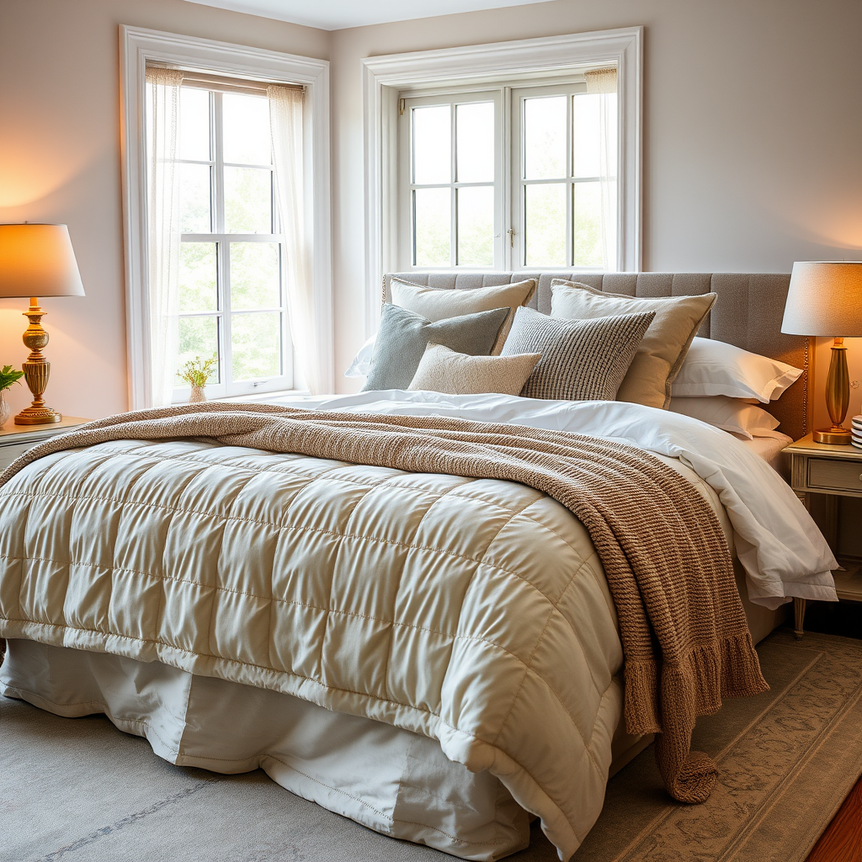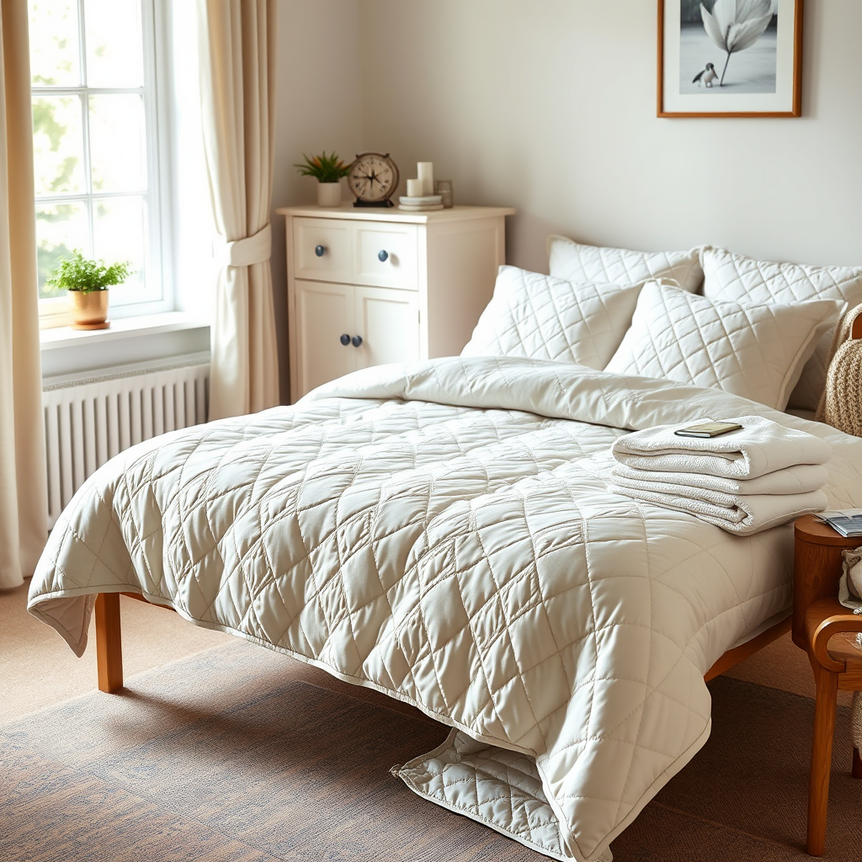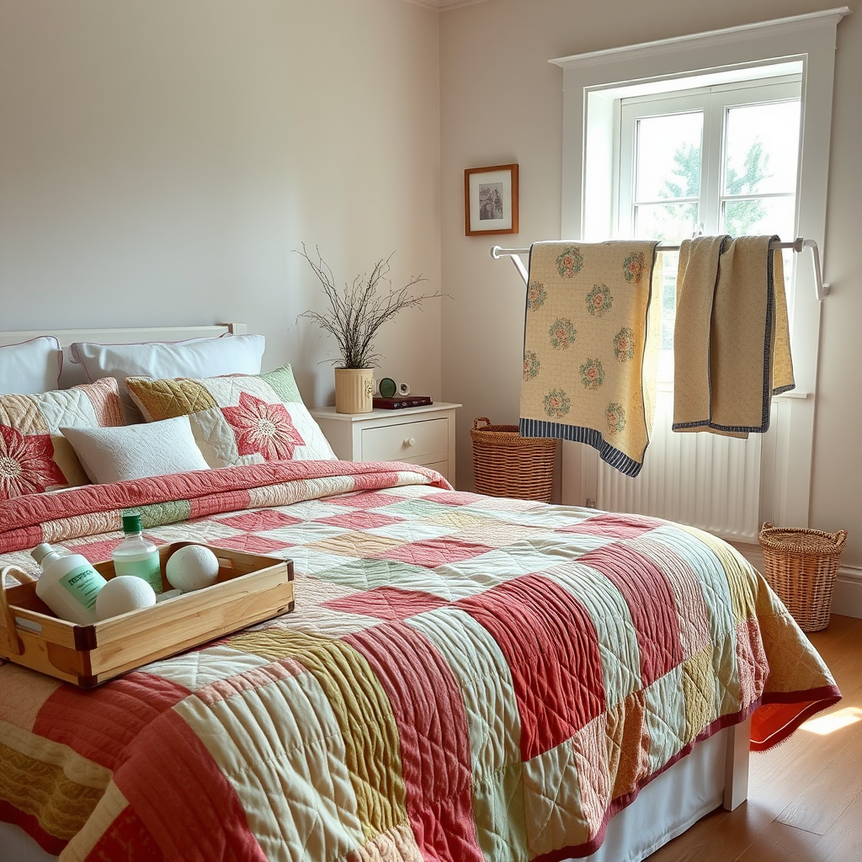Creating a beautifully layered bed with a quilt bedspread set is an art that balances style, comfort, and functionality, transforming your bedroom into a serene sanctuary. For UK homeowners and interior design enthusiasts, understanding the nuances of bedding layers is key to achieving that coveted, professionally styled look. This comprehensive guide will walk you through expert techniques, ensuring your bed is not only welcoming and aesthetically pleasing but also perfectly suited for year-round comfort in a British home.
1. Why Choose a Quilted Bedspread Set? Understanding Its Style and Function
Key Features of Quilted Bedspreads
Quilted bedspread sets are distinguished by their unique stitched, padded design, which imparts both exquisite texture and comforting warmth. This time-honoured quilting technique involves stitching together multiple layers of fabric with a soft filling in between, creating a visually rich surface. The patterns can range from classic diamond or channel stitches to more intricate, decorative motifs like florals or geometric designs. Beyond their aesthetic appeal, quilted bedspreads offer enhanced durability, making them a long-lasting addition to your bedroom.
Benefits of Layering with a Quilted Set
Layering with a quilted bedspread adds significant depth and dimension to your bed, making it appear plush and inviting. A quilt acts as a central statement piece, effortlessly tying together your room’s colour palette and overall design theme. Functionally, it provides an ideal extra layer of warmth without the bulk often associated with heavier duvets, making it perfectly suited for the UK’s transitional seasons or for those who prefer a lighter covering in milder climates. Its versatility allows for easy adjustment, offering warmth when needed and a stylish drape when not.
Materials and Design Variations Explained
Quilted bedspread sets come in a diverse array of fabrics, each offering distinct benefits. Our 3-Piece Quilt Bedspread Set, for instance, offers a versatile option that adds texture and colour variety to your space. Common materials include breathable cotton, resilient microfiber, and rustic linen, alongside various blends. Cotton is celebrated for its softness, breathability, and natural feel, ideal for those who tend to sleep warm. Microfiber offers exceptional wrinkle and stain resistance, making it a practical choice for busy households, while linen provides a wonderfully textured, moisture-wicking surface with a relaxed, elegant look. Design-wise, the options are limitless, ranging from minimalist solid colours to vibrant florals, intricate patchwork, or contemporary geometric patterns, ensuring you can find a set that perfectly complements your personal aesthetic and existing bedroom decor.
Table: Common Quilt Materials & Their Benefits
| Material | Key Benefits | Best For |
|---|---|---|
| Cotton | Soft, breathable, durable, hypoallergenic, easy to care for. | Year-round comfort, sensitive skin, natural feel. |
| Microfiber | Wrinkle-resistant, stain-resistant, very soft, affordable, quick-drying. | Durability, low maintenance, busy households, children’s rooms. |
| Linen | Moisture-wicking, highly breathable, gets softer with age, unique textured look. | Warm sleepers, rustic or natural decor styles, luxury feel. |
2. Building the Perfect Foundation: Essential Bed Layers Before the Quilt
Importance of Quality Sheets and Mattress Protectors
The secret to a truly luxurious and comfortable bed begins with its base layers. Invest in high-thread-count sheets made from natural fibres like cotton or bamboo. These materials are not only incredibly soft against the skin but also highly breathable, ensuring a comfortable night’s sleep regardless of the season. A smooth, wrinkle-free fitted sheet creates the perfect canvas for subsequent layers, while a well-chosen flat sheet adds an extra touch of comfort. Equally vital is a good quality mattress protector; it acts as an invisible shield, guarding your mattress against spills, stains, dust mites, and allergens, thereby prolonging its life and maintaining hygiene. For those with allergies, a hypoallergenic protector is a wise investment.
Best Base Layers to Support the Quilted Bedspread
Beneath your beautiful quilted bedspread, consider adding a lightweight blanket or a thin duvet. This layer serves multiple purposes: it offers adjustable warmth, allowing you to easily regulate your temperature, and provides additional softness without overwhelming the quilt’s texture. Ensure these foundational layers are harmonious in weight and volume to prevent any unwanted bulkiness. For a polished look, choose base layers that complement your quilt’s colour scheme, even if they’re mostly hidden. Simple, solid colours often work best here, allowing the quilt to be the star.
How to Prepare Your Bed for Layering
Achieving a designer-level layered bed starts with meticulous preparation. Begin by ensuring your bed is freshly made, with all sheets pulled taut and smooth. Wrinkles can detract from even the most carefully arranged layers, so take the time to smooth them out. Tuck in your fitted sheet securely, and then position your flat sheet evenly, folding the top edge down neatly over your blanket or thin duvet. This crisp, neat canvas allows your quilted bedspread to lie perfectly flat, or drape gracefully, creating an elegant and inviting focal point in your bedroom.
3. Mastering the Art of Strategic Layer Placement
How to Layer for Both Comfort and Aesthetics
Strategic layering is about finding the perfect balance between visual appeal and practical comfort. The standard approach begins with your fitted and flat sheets, followed by a lightweight blanket or a thin duvet. This provides foundational warmth. Then, place your quilted bedspread on top. For a classic look, spread the quilt fully over the bed, letting it drape evenly on all sides. Alternatively, for a more relaxed or transitional style, fold the quilt at the foot of the bed, showcasing its reverse side or a coordinating sheet underneath. This method ensures warmth is easily accessible but can be peeled back or removed as temperatures change.
Positioning the Quilted Bedspread for Maximum Impact
The way you position your quilted bedspread significantly impacts the overall look. In warmer months or for a minimalist aesthetic, folding the quilt neatly at the foot of the bed allows its pattern or texture to be a subtle yet impactful accent, leaving your crisp sheets visible. During colder periods, or for maximum cosiness, spread the quilt fully over the entire bed, ensuring it hangs evenly over the sides and foot. A common designer trick is to allow approximately 12-18 inches of drop on each side, creating a luxurious, tailored appearance. Avoid uneven lengths or bunched fabric, as this can make the bed look untidy rather than artfully layered.
Combining Layers Without Bulkiness or Clutter
The key to elegant layering is restraint. Resist the urge to pile on too many thick layers; typically, 3-4 coordinated pieces are sufficient. When selecting your layers, opt for items in similar weights, or choose a lighter weight duvet if you plan to use a thick quilt on top. Avoid doubling up on heavy comforters beneath your quilt, as this will create an unnecessarily bulky and often messy appearance. To maintain a streamlined, uncluttered aesthetic, keep your colour palette cohesive. Instead of contrasting colours dramatically, focus on contrasting textures. For example, a smooth cotton sheet, a waffle-knit blanket, and a softly quilted bedspread can create visual interest without feeling overwhelming.
4. Pillow Styling Techniques to Complement Your Quilted Bedspread
Selecting Pillow Types and Sizes for Layered Looks
Pillows are the crowning glory of a layered bed, adding depth and personality. Start with your standard sleeping pillows (typically two for a double bed, four for a king), placing them flat against the headboard. Next, introduce larger Euro shams (square pillows, usually 65x65cm) in matching or coordinating colours, positioned in front of the sleeping pillows. These add height and a luxurious feel. Finally, accent with decorative throw pillows in assorted sizes and shapes – from medium square cushions (45x45cm) to smaller rectangular bolsters or lumbar pillows. The variety in size prevents a monotonous look and adds visual interest.
Arranging Decorative and Functional Pillows Harmoniously
There are several effective arrangements for pillows. A classic setup involves placing your sleeping pillows at the very back, against the headboard. In front of these, lean your Euro shams. Then, arrange your smaller accent pillows in front of the shams. You can opt for perfect symmetry, where each side mirrors the other, for a formal, balanced look. Alternatively, embrace asymmetry for a more relaxed, modern feel, perhaps with an odd number of accent pillows artfully clustered. The goal is to ensure the pillows enhance, rather than overpower, your quilt’s main design. Aim for a cohesive visual flow from the headboard down to the foot of the bed.
Mixing Textures and Patterns That Enhance the Quilt Design
To truly elevate your bed styling, experiment with mixing textures and patterns among your pillows. If your quilted bedspread has a dominant pattern, select pillows in solid colours that echo shades from the quilt, but introduce different textures like smooth linen, plush velvet, cosy faux fur, or chunky woven fabrics. If your quilt is solid, use patterned pillows to add visual flair, ensuring the patterns complement rather than clash. Geometric patterns can modernise, while florals can soften the look. The key is to create tactile variety that invites touch and adds a sophisticated, curated feel to your entire bedding ensemble.
5. Enhancing Texture and Warmth: Using Rugs and Accessories in Your Bedroom
Incorporating Rugs to Add Warm-
th and Texture Around the Bed
Beyond the bed itself, area rugs play a crucial role in enhancing the warmth and texture of your bedroom. Position a plush or richly textured rug, such as a deep-pile wool rug or a soft shag rug, so that it extends significantly beyond the bed frame. This not only anchors the sleeping area visually but also provides a luxurious, warm surface for your feet when you step out of bed. Choose neutral tones or subtle patterns that harmonise with your quilt’s colours, ensuring visual continuity and a sense of calm. For smaller rooms, a runner on either side of the bed can achieve a similar effect without overwhelming the space.
Coordinating Bedroom Accessories with Your Quilted Bedspread
The beauty of a well-designed bedroom lies in its cohesive details. Use bedroom accessories to echo or complement the colours and style of your quilted bedspread. Consider elements like bedside lampshades, decorative throws draped over an armchair, or window dressings like curtains or blinds. These items offer excellent opportunities to introduce complementary or accent colours pulled directly from your quilt’s design. Metallic accents, such as a brass lamp base or a silver photo frame, can add a touch of sparkle and dimension without clashing, while wooden elements can bring natural warmth. Always ensure accessories are in scale with the room and the bed, avoiding anything that looks too small or too large.
Tips for Choosing Complementary Color Schemes and Materials
To create a harmonious and inviting bedroom, stick to a defined colour palette. Pick accessories that subtly echo the key colours found in your quilt, or introduce soft contrasting shades to add visual interest without creating overload. For example, if your quilt features shades of blue and cream, introduce throw pillows in a deeper navy or a soft grey. When it comes to materials, lean towards natural, cosy options that enhance the feeling of warmth and comfort. Wool throws, cotton storage baskets, or leather-bound books on a bedside table all contribute to a cohesive and inviting atmosphere, maintaining the luxurious and comfortable coherence you’ve built with your layered bed.
6. Seasonal Layering Adjustments for UK Homes: Staying Cozy Year-Round
Adapting Bedding Layers Through Different UK Seasons
The ever-changing UK weather demands flexibility in your bedding choices. Adapting your layers ensures year-round comfort. During the warmer spring and summer months, opt for lightweight, breathable cotton or linen sheets and keep your quilt folded stylishly at the foot of the bed, ready for cooler evenings. For the transition into autumn, you might introduce a thin wool or fleece blanket beneath the quilt for a touch more warmth. As winter sets in, swap to cosy flannel sheets and add an extra blanket or a heavier duvet beneath your quilt. This method allows your beautiful quilt bedspread set to remain a constant stylistic element while its functionality adapts to the season.
Choosing Breathable vs. Insulating Materials for Quilts
While the quilt itself might be a consistent piece, the choice of its material significantly impacts its seasonal suitability. For optimal breathability in warmer periods, especially if you tend to overheat, a quilt made from 100% cotton or a linen blend is ideal. These natural fibres allow air to circulate, wicking away moisture to keep you cool. Conversely, for the biting chill of UK winters, consider quilts with more insulating fillings, such as heavier cotton batting, wool, or synthetic fibres designed for warmth. Many quilts are designed to be versatile, so the emphasis then shifts to the layers you place underneath and on top.
Practical Tips for Transitioning Your Bedspread Set with the Weather
Smooth seasonal transitions are key to maintaining a fresh, comfortable bedroom. As temperatures shift, rotate your quilts and base layers accordingly. Store off-season bedding properly – in breathable bags or containers – to prevent mustiness and keep fabrics fresh. When bringing them out, a quick air-out or a refresh cycle in the dryer with a dryer sheet can work wonders. Furthermore, don’t shy away from mixing textures to elevate warmth and luxury; adding a soft cashmere throw or a chunky knitted blanket over your quilt in winter can significantly boost cosiness and add a refined touch to your bedding ensemble.
7. Avoiding Common Layering Mistakes: Professional Tips for a Polished Look
Overcoming Cluttered or Uneven Layering
One of the most common layering pitfalls is creating a cluttered or uneven look. To avoid this, limit your main bed layers to typically three to four coordinated pieces, including your sheets, a lightweight blanket or duvet, and the quilt itself. Ensure that each layer is smoothed out and tucked in neatly, and that their edges align evenly. Each layer should be distinctly visible without one overwhelming the others. The goal is a sense of effortless abundance, not a chaotic pile. If your bed looks messy, it’s likely too many layers are being used or they aren’t properly spread and tucked.
Mistakes in Fabric Coordination and Color Matching
Another frequent error is mixing too many conflicting patterns or clashing colours. While texture play is encouraged, wild colour and pattern combinations can quickly make a bedroom feel overwhelming rather than serene. Stick to a defined colour palette, perhaps 2-3 main colours and a neutral, and then play with variations in shade and texture within that palette. If your quilt is heavily patterned, opt for solid or subtly textured sheets and pillows. If your quilt is solid, use accent pillows with complementary patterns. The aim is cohesion and visual harmony, where each element contributes to a unified aesthetic.
How to Maintain Your Layered Bedspread for Lasting Style
Maintaining the fresh, designer-inspired look of your layered bed requires ongoing care. Regularly wash and air your quilts, sheets, and pillowcases according to their specific care instructions. Most cotton and microfiber quilts are machine washable; use a gentle cycle with cold or warm water and a mild detergent. Avoid using bleach, which can damage fabrics and colours. For drying, tumble dry on a low heat setting or, preferably, air dry flat to help preserve the quilt’s shape, stitching, and fabric integrity. Regular airing can also help keep it fresh.
Transform your bedroom into a designer haven by mastering bed layering with a 3-Piece Quilt Bedspread Set – where function meets refined elegance. Explore our range to find the perfect addition to your home today.
FAQs About Quilted Bedspread Sets
Q: How do I choose the right size quilt bedspread for my bed?
A: To achieve an elegant drape and full coverage, select a quilt bedspread that is slightly larger than your mattress size. A general guideline is to allow for approximately 12-18 inches of drop on each side and at the foot of the bed. This ensures the quilt extends comfortably over the mattress and base, providing a luxurious, full appearance rather than looking too small or skimpy. Always measure your bed dimensions before purchasing.
Q: Can I use a quilted bedspread set year-round in the UK?
A: Absolutely! Quilted bedspread sets are highly versatile for year-round use in the UK. The key lies in adjusting the layers beneath them. In warmer months (spring/summer), pair your quilt with lightweight cotton or linen sheets and perhaps no additional blanket. For autumn and winter, simply add heavier blankets, flannel sheets, or a thin duvet underneath to enhance warmth and insulation, allowing your quilt to remain a stylish centrepiece.
Q: How do I clean and maintain my quilt bedspread to keep it looking new?
A: Always follow the specific care instructions provided by the manufacturer on the label. Most cotton and microfiber quilts are machine washable; use a gentle cycle with cold or warm water and a mild detergent. Avoid using bleach, which can damage fabrics and colours. For drying, tumble dry on a low heat setting or, preferably, air dry flat to help preserve the quilt’s shape, stitching, and fabric integrity. Regular airing can also help keep it fresh.Read our detailed guide on How to wash and care for your Quilt Bedspread Set.
Q: What’s the main difference between a quilt and a duvet, and why choose a quilt?
A: The primary difference lies in their construction and use. A quilt is typically thinner, featuring multiple layers of fabric with a soft filling stitched together in a decorative pattern, and is used as a standalone top layer or part of a layered ensemble. Duves, on the other hand, are generally thicker, designed to be used with a removable duvet cover, and primarily serve as the main source of warmth. Quilts are often chosen for their lighter weight, integrated design, and ease of layering, offering a different aesthetic and functional benefit compared to a bulkier duvet.



